
All categories
Featured selections
Trade Assurance
Buyer Central
Help Center
Get the app
Become a supplier

(14378 products available)


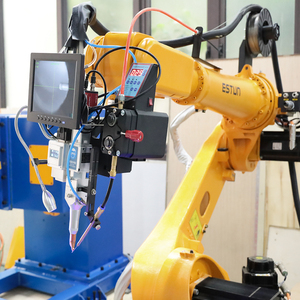



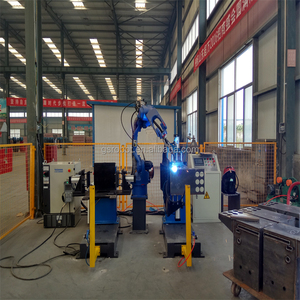
























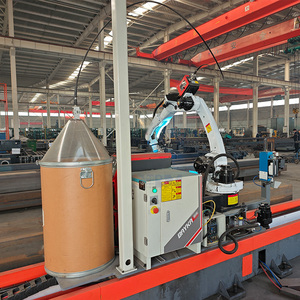
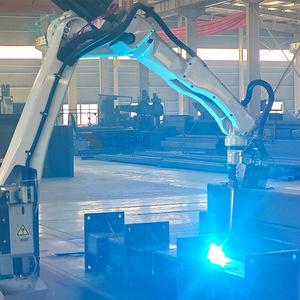







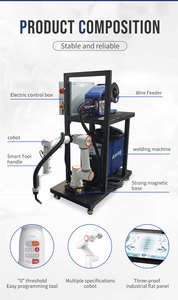




When selecting a six-axis robotic welder, it's vital to consider the specific needs for mechanical and welding operations due to the variations in structure and functionality. Here is a description of the types of six welding robots:
Automatic welding robots
Automatic 6-axis welding robots are programmed to perform welding operations without much need for human intervention. After being set up, these robots perform mass production with very minimal defects and homogeneous quality. To ensure optimal functionality, automatic welding robots have to be integrated with automated plasma and arc parameters. To be specific, automatic 6-axis arc welding robots are relevant for companies that produce many products that require welding.
Manual welding robots
6-axis manual welding robots entail programming by hand or teaching by demonstration. Humans could have a hand in things through a few forms of intervention, especially when the contracts do not require repetitive tasks. Such robots can be suited for smaller, complex jobs or situation-specific tweaking. Since versatility is the term used to describe these kinds of welding robots, it is heavily utilized in small and niche manufacturers that cannot afford the luxury of high-end welding machines.
Orbital welding robots
Orbital welding robots specialize in welding on pipes and tubes, making complete revolution around the surfaces. These robotic welding systems suites schedule restrictions because they carry out consistent and precise circumferential joins. Due to their ability and uniqueness, such welding robots can be found in the industries that deal in critical fabrication like petrochemicals and constructions. They offer great improvement in the quality of weld and reduce the chances of human error. Orbital welding robots are a must-have in any industry that deals with a massive production of pipes and tubes.
Spot welding robots
Spot welding robots are designed to perform resistance welding at targeted spots on the workpieces. Their articulated arm structure provides flexibility in reaching different locations for precise welding tasks. Production of automobile body structures where spot welding is frequently utilized will benefit from these robots. However, larger runs of work or complex welding work may necessitate an alternate form of robot.
TIG welding robots
TIG (Tungsten Inert Gas) welding robots are designed for precision welding with a high degree of control. They are ideal for welding thin materials or providing clean, high-quality welds on metals like aluminum, stainless steel, and titanium. These robots are frequently used in aerospace, automotive, and construction industries. Industries that require very precise welds have robotic welding cells integrated with TIG welding machines.
Automotive industry
Welding robots used in the automotive industry are primarily applied in the production of car chassis and bodies. Electric and robotic welding are more precise than human hands and result in working time that is stronger and less likely to break. Saving time and reducing human error basically means that there will be an increase in production rate.
Aerospace
Welding in the aerospace sector requires comes with a great demand in terms its quality and precision. In this case six-cell welding robots work great because machines can provide better and more precise TIG welding. Additionally, these six welding axes can move in to reach complex geometries found in aerospace parts. Employing welding robots was instrumental in helping industries comply with strict safety measures.
Shipbuilding
The construction of ships involves extensive welding, and 6-axis robots are employed to weld hulls, decks, and other large structures. These robots provide the flexibility needed to weld in vertical, horizontal, and overhead positions, which are common in shipbuilding. In shipbuilding, 6-axis welding robots can also be applied in pipe and frame welding.
Pipe and frame welding
Welding robots offer a great level of performance and have the ability to perform orbital welding on a wide range of pipes and tube structures. These robots are a major improvement for industries like oil and gas, chemical processing, and power generation. A 6-axis welding robot provides the necessary flexibility for curved welding, which is difficult for most automated systems to achieve. This versatility enhances the quality of the weld while at the same time reducing the chances of defects occurring.
Metal fabrication
Businesses in the metal fabrication industry take advantage of robotic welding in order to work faster with a wider variety of materials, like mild steel and aluminum, and also on different types of products. 6-axis machines are able to reach more complex geometric shapes, which makes them ideal for assembling Readymade items such as metal cabinets, racks, and other structures. The muscles of automated welding in metal fabrication produce more consistent results, as well as mandatory cost savings.
Construction
In the construction realm, robotic welding is majorly applied in the fabrication of steel structures such as beams, columns, and trusses. Automation in welding has the ability to enhance speed, accuracy, and efficiency in the construction process. Robotic welding machines can perform complex joints and connections, hence improving the quality of the structure. Further, the use of these technologies enables for more complex joints and connections, improving the structural integrity further. This technology also improves working conditions on-site by reducing the exposures to dangerous working environments.
Railway industry
Robotic welding is used to construct railway carriages or tracks and is applied in the Railway industry. In this field, robotic welding brings out the same benefits observed in other fields: consistency, precision, and efficiency. Whether they are constructing railway cars or tracks, the application of robotic welding results in stronger welds and improved safety records. Further, 6-axis robots are for joints and connections that are quite complex, and they ensure the quality of the structure is improved.
Electronics
In the electronics industry, welding robots are employed in the process of manufacturing components such as circuit boards and casings. Moreover, in this aspect, robotic welding is concerned with micro-welding or laser welding. Laser welding machine is used in this process due to its precision and is widely used in materials like gold, copper, and silver, which are widely used in electronics. Robotic micro welding is an indispensable technology in the electronics industry, particularly in the production of electronic items such as circuit boards, components, and casings. Circuit boards have delicate materials that require intense accuracy while welding, and hence, robots are perfect for this job.
Specified key features that make six welding axis robots ideal for welding operations. Understanding these specifications helps businesses choose the right robot for their manufacturing needs.
Degree of freedom
A six-axis robotic welding machine has six degrees of freedom; hence, it can perform welding in any position. Due to this flexibility, the robot is ideal for working on even the most complex welded structures. To put it more plainly, the last three axes are oriented in the end-effector to provide the engagement of the welding torch with the workpiece, while the first three are designated as orbital rotations for positioning the torch in various angles.
Load capacity
This means that the robotic arm should be able to maneuver its end-effector while carrying a load. Welding electrodes attach to the end of the robot arm; in most cases, it is a tolerable weight for the robot. In cases where the robot is not able to handle the weight, it could lead to poor welding or even breakdown of the device. Companies have to consider the maximum load and weight of the components to be welded so that they can select the right robot.
Welding type
Robotic welders are used in different types of welds, which include MIG, TIG, and spot welding. These welding methods applied to a welding robot depend on the type of welding that is mostly used in the respective industry. For example, a robot that is used for TIG welding is characterized by precision and clean welds, especially in nonferrous metals. Automated welding, especially with MIG welding, is popularly used in mass production because of its speed. Resistance welding is not that commonly done but rather in industries such as automobile manufacture.
Controller
Currently, modern welding robots feature advanced controller systems that allow for simple programming and precise motion control. Most controllers are designed for user-friendliness, and most of them employ 3D graphical interfaces for easy teaching and path planning. Advanced controllers also have integrated sensors for real-time feedback. Welding parameters can be adjusted dynamically to keep welding conditions optimal at any point in time.
End-effector
The end-effector is an integral part of the robot as it contains the welding tool. Most common end-effectors are welding torches or electrodes. The kind of end-effector used is as a result of type of welding performed and also the material. For instance, TIG welding robots will have different appendages compared to MIG or spot welding. It is also possible to have welding robots with end-effectors that can be replaced with ease, thus making it possible to switch from one welding method to another without much hassle.
Repetition accuracy
Repeating accuracy in welding robots is an indicator of the robot's ability to perform consecutive operations with the same degree of accuracy. This is a very important aspect of welding since any minor deviation during the process may make the difference between a good and bad weld. In general, 6-axis robotic welding arms have a repetition accuracy range between ±0.1mm to ±0.5mm. For general manufacturing, this accuracy is alright, but for industries that require tighter accuracy, it is important to select a robot with a higher degree of accuracy.
Welding method
Welding techniques performed by the welding robot should therefore match the method of welding required. A robotic welding machine can perform MIG or flux core welding and can be applied for mass production of robust welds. TIG welding requires a welding robot that will provide fine control, and that's why it is ideal for the types of materials we talked about before: aluminum, stainless steel, and titanium. If resistance spot welding is required, there are robots designed especially for this application, particularly in the automobile industry.
Load capacity
Load capacity is one of the most important factors to consider when purchasing a loader. Find out the weight of the workpieces that need to be welded and get a robot with an appropriate load-bearing capacity. The load capacity should be higher than the weight of the components, and this is to ensure that the welding process is not affected in any way. If the robot struggles to carry a load that is too heavy for it, it will lead to poor performance and damage the equipment. Conversely, a robot carrying a light load than its maximum limit may result in loss of efficiency.
Working envelope
The working envelope refers to the welding robot's three-dimensional working space. The size of the working envelope has to correspond to the dimensions of the components that are to be welded. If the robot has a small working envelope, then it will be impossible for it to accommodate large workpieces, and a large robot for small tasks means it will be less awkward. Basically, if considering the size of an envelope, it is vital to ensure that all movement within the robot's reach is free from obstruction.
Material
6-axis welding robots used in industry are probably the most versatile piece of equipment, as they can handle different materials like steel, aluminum, copper, and even exotic carbon fiber. These materials are unique because each has its own physical and chemical characteristics in terms of thickness and bending, which a robot has to deal with. Welds on thin sheets abrasive materials are best done by using a robot that has a higher load-carrying capacity and is highly accurate, while those for thick materials need to have a machine equipped with high power and torques.
Choose a trusted supplier
Choosing a dependable provider is imperative in obtaining a welding robot that is intended to be reliable, according to specifications, and capable of rendering services as promised. Purchasing a robot from established companies comes with added benefits like warranty, technical support, and possible software updates at a future date. In addition, companies that are proven to have been in the business for a long time will provide you with customer references that can be matched with what is required.
A1: One of the major benefits is that robots can work continuously with a higher degree of accuracy and consistency. They minimize human error; they also work in hazardous conditions and increase production rates.
A2: These automated welding robots are widely used in the automotive, aerospace, shipbuilding, pipe and frame welding, construction, and railway industries.
A3: The robotic welding machine can handle flux core, resistance, and orbital welding, depending on the industry and application.
A4: Due to their flexibility, these robots can maneuver around intricate designs, making them ideal for tasks requiring precision in multiple orientations.
A5: If a robot is unable to bear the weight of the workpiece, it will lead to poor performance during the welding process, meaning that it must match the robot's load capacity with the workpiece's weight.